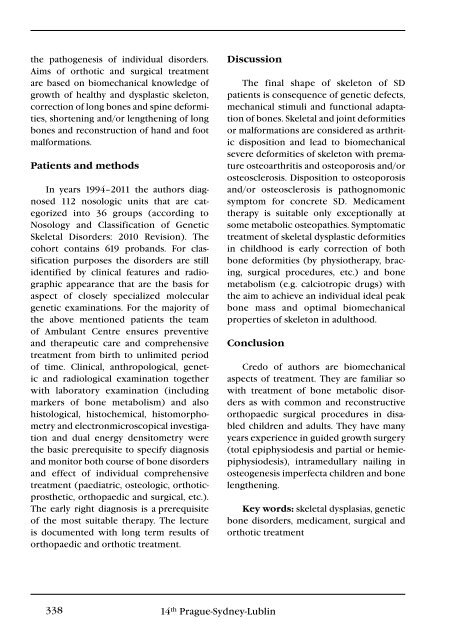3+4+Supplementum/2012 - Společnost pro pojivové tkáně
3+4+Supplementum/2012 - Společnost pro pojivové tkáně
3+4+Supplementum/2012 - Společnost pro pojivové tkáně
- TAGS
- www.pojivo.cz
Create successful ePaper yourself
Turn your PDF publications into a flip-book with our unique Google optimized e-Paper software.
the pathogenesis of individual disorders.<br />
Aims of orthotic and surgical treatment<br />
are based on biomechanical knowledge of<br />
growth of healthy and dysplastic skeleton,<br />
correction of long bones and spine deformities,<br />
shortening and/or lengthening of long<br />
bones and reconstruction of hand and foot<br />
malformations.<br />
Patients and methods<br />
In years 1994–2011 the authors diagnosed<br />
112 nosologic units that are categorized<br />
into 36 groups (according to<br />
Nosology and Classification of Genetic<br />
Skeletal Disorders: 2010 Revision). The<br />
cohort contains 619 <strong>pro</strong>bands. For classification<br />
purposes the disorders are still<br />
identified by clinical features and radiographic<br />
appearance that are the basis for<br />
aspect of closely specialized molecular<br />
genetic examinations. For the majority of<br />
the above mentioned patients the team<br />
of Ambulant Centre ensures preventive<br />
and therapeutic care and comprehensive<br />
treatment from birth to unlimited period<br />
of time. Clinical, anthropological, genetic<br />
and radiological examination together<br />
with laboratory examination (including<br />
markers of bone metabolism) and also<br />
histological, histochemical, histomorphometry<br />
and electronmicroscopical investigation<br />
and dual energy densitometry were<br />
the basic prerequisite to specify diagnosis<br />
and monitor both course of bone disorders<br />
and effect of individual comprehensive<br />
treatment (paediatric, osteologic, orthotic<strong>pro</strong>sthetic,<br />
orthopaedic and surgical, etc.).<br />
The early right diagnosis is a prerequisite<br />
of the most suitable therapy. The lecture<br />
is documented with long term results of<br />
orthopaedic and orthotic treatment.<br />
discussion<br />
338 14 th Prague-Sydney-Lublin<br />
The final shape of skeleton of SD<br />
patients is consequence of genetic defects,<br />
mechanical stimuli and functional adaptation<br />
of bones. Skeletal and joint deformities<br />
or malformations are considered as arthritic<br />
disposition and lead to biomechanical<br />
severe deformities of skeleton with premature<br />
osteoarthritis and osteoporosis and/or<br />
osteosclerosis. Disposition to osteoporosis<br />
and/or osteosclerosis is pathognomonic<br />
symptom for concrete SD. Medicament<br />
therapy is suitable only exceptionally at<br />
some metabolic osteopathies. Symptomatic<br />
treatment of skeletal dysplastic deformities<br />
in childhood is early correction of both<br />
bone deformities (by physiotherapy, bracing,<br />
surgical <strong>pro</strong>cedures, etc.) and bone<br />
metabolism (e.g. calciotropic drugs) with<br />
the aim to achieve an individual ideal peak<br />
bone mass and optimal biomechanical<br />
<strong>pro</strong>perties of skeleton in adulthood.<br />
Conclusion<br />
Credo of authors are biomechanical<br />
aspects of treatment. They are familiar so<br />
with treatment of bone metabolic disorders<br />
as with common and reconstructive<br />
orthopaedic surgical <strong>pro</strong>cedures in disabled<br />
children and adults. They have many<br />
years experience in guided growth surgery<br />
(total epiphysiodesis and partial or hemiepiphysiodesis),<br />
intramedullary nailing in<br />
osteogenesis imperfecta children and bone<br />
lengthening.<br />
key words: skeletal dysplasias, genetic<br />
bone disorders, medicament, surgical and<br />
orthotic treatment

















